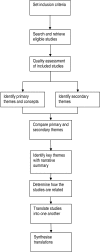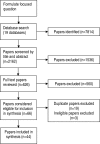Patient adherence to tuberculosis treatment: a systematic review of qualitative research
- PMID: 17676945
- PMCID: PMC1925126
- DOI: 10.1371/journal.pmed.0040238
Patient adherence to tuberculosis treatment: a systematic review of qualitative research
Abstract
Background: Tuberculosis (TB) is a major contributor to the global burden of disease and has received considerable attention in recent years, particularly in low- and middle-income countries where it is closely associated with HIV/AIDS. Poor adherence to treatment is common despite various interventions aimed at improving treatment completion. Lack of a comprehensive and holistic understanding of barriers to and facilitators of, treatment adherence is currently a major obstacle to finding effective solutions. The aim of this systematic review of qualitative studies was to understand the factors considered important by patients, caregivers and health care providers in contributing to TB medication adherence.
Methods and findings: We searched 19 electronic databases (1966-February 2005) for qualitative studies on patients', caregivers', or health care providers' perceptions of adherence to preventive or curative TB treatment with the free text terms "Tuberculosis AND (adherence OR compliance OR concordance)". We supplemented our search with citation searches and by consulting experts. For included studies, study quality was assessed using a predetermined checklist and data were extracted independently onto a standard form. We then followed Noblit and Hare's method of meta-ethnography to synthesize the findings, using both reciprocal translation and line-of-argument synthesis. We screened 7,814 citations and selected 44 articles that met the prespecified inclusion criteria. The synthesis offers an overview of qualitative evidence derived from these multiple international studies. We identified eight major themes across the studies: organisation of treatment and care; interpretations of illness and wellness; the financial burden of treatment; knowledge, attitudes, and beliefs about treatment; law and immigration; personal characteristics and adherence behaviour; side effects; and family, community, and household support. Our interpretation of the themes across all studies produced a line-of-argument synthesis describing how four major factors interact to affect adherence to TB treatment: structural factors, including poverty and gender discrimination; the social context; health service factors; and personal factors. The findings of this study are limited by the quality and foci of the included studies.
Conclusions: Adherence to the long course of TB treatment is a complex, dynamic phenomenon with a wide range of factors impacting on treatment-taking behaviour. Patients' adherence to their medication regimens was influenced by the interaction of a number of these factors. The findings of our review could help inform the development of patient-centred interventions and of interventions to address structural barriers to treatment adherence.
Conflict of interest statement
Figures
References
-
- Dye C. Global epidemiology of tuberculosis. Lancet. 2006;367:938–939. - PubMed
-
- Corbett EL, Marston B, Churchyard CJ, De Cock KM. Tuberculosis in sub-Saharan Africa: Opportunities, challenges, and change in the era of antiretroviral treatment. Lancet. 2006;367:926–937. - PubMed
-
- WHO. An expanded DOTS framework for effective tuberculosis control. WHO/CDS/TB/2002.297. Geneva: World Health Organization; 2002. 23. p. Available at: http://whqlibdoc.who.int/hq/2002/WHO_CDS_TB_2002.297.pdf. Accessed:12 October 2006.
-
- Cuneo WD, Snider DE. Enhancing patient compliance with tuberculosis therapy. Clin Chest Med. 1989;10:375–380. - PubMed
-
- Volmink J, Garner P. Directly observed therapy for treating tuberculosis. Cochrane Database Syst Rev. 2006;2 CD003343. doi: 10.1002/14651858.CD003343.pub2. - DOI - PubMed
Publication types
MeSH terms
LinkOut - more resources
Full Text Sources
Medical
Miscellaneous




